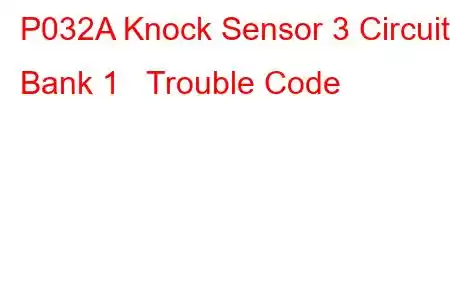P032A Knock Sensor 3 Circuit (Bank 1)
OBD-II Trouble Code Technical Description
Knock Sensor 3 Circuit Malfunction (Bank 1)
What does that mean?
This diagnostic trouble code (DTC) is a generic powertrain code, which means that it applies to OBD-II equipped vehicles (Dodge, Ram, Ford, GMC, Chevrolet, VW, Toyota, etc.). Although generic, the specific repair steps may vary depending on make/model.
A P032A trouble code means that the powertrain control module (PCM) has detected an unexpected sensor reading from the knock sensor #3 on bank 1. On engines with more than one bank, bank 1 is the bank of cylinders that contains cylinder #1. Refer to a vehicle specific repair source to determine which sensor is knock sensor #3.
Typically threaded directly into the engine block, the knock sensor is a piezoelectric sensor. The location of the sensors in a multi-sensor system may vary between manufacturers but most are in the sides of the block (between water jacket freeze plugs). Knock sensors that are in the sides of the engine block are often threaded directly into engine coolant passages. When the engine is warm and the engine cooling system is under pressure, removal of these sensors could result in severe burns from hot coolant. Before removing a knock sensor, allow the engine to cool and always dispose of coolant properly.
A piezoelectric sensing crystal is at the heart of the knock sensor. When shaken or vibrated, the piezoelectric crystal produces a small amount of voltage. Since the knock sensor control circuit is normally a one-wire ground circuit, the voltage generated by the vibration is recognized by the PCM as engine noise or vibration. The severity of the vibration encountered by the piezoelectric crystal (inside the knock sensor) determines the level of voltage produced in the circuit.
If the PCM detects a degree of knock sensor voltage indicative of a spark detonation; it may retard ignition timing and no knock sensor control code may be stored. If the PCM detects a level of knock sensor voltage that indicates a more severe engine noise (such as a connecting rod contacting the inside of the engine block), it may discontinue fuel delivery and ignition spark to the affected cylinder and a knock sensor code will be stored.
Code Severity & Symptoms
A stored code P032A should be considered severe because it could indicate internal engine failure.
Symptoms of this code may include:
Hesitation when accelerating Below normal engine performance Abnormal noises from the engine area Increased fuel consumptionCauses
Potential causes for this code to set are:
Ignition misfire Faulty knock sensor Internal engine problem Contaminated or subpar fuel used Defective knock sensor control wiring and/or connectors Bad PCM or a PCM programing errorDiagnostic and Repair Procedures
To diagnose a code P032A, a diagnostic scanner, a digital volt/ohmmeter (DVOM), and a reliable vehicle specific repair resource will be necessary. If the engine sounds like it is knocking, or excessively noisy, address that issue before attempting a diagnosis for any knock sensor codes.
Check for technical service bulletins (TSBs) that may apply to your year/make/model. If the issue is a known issue there may exist a bulletin to help with diagnosis and repair specific to your exact problem. That can save you time and money.
Start with a visual inspection of all system related wiring harnesses and connectors. Look for corroded, burnt, or otherwise damaged wiring and connectors that may create an open or shorted circuit. Knock sensors are often in the lower part of the engine block. This makes them susceptible to damage when heavy parts (like starters and engine mounts) are replaced. System connectors, wiring, and fragile knock sensors are frequently broken during repairs in the vicinity.
Connect the OBD-II
Read: 45


